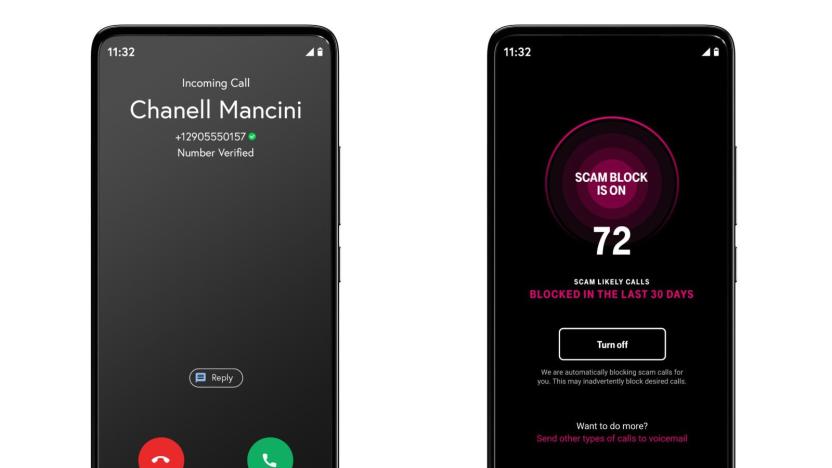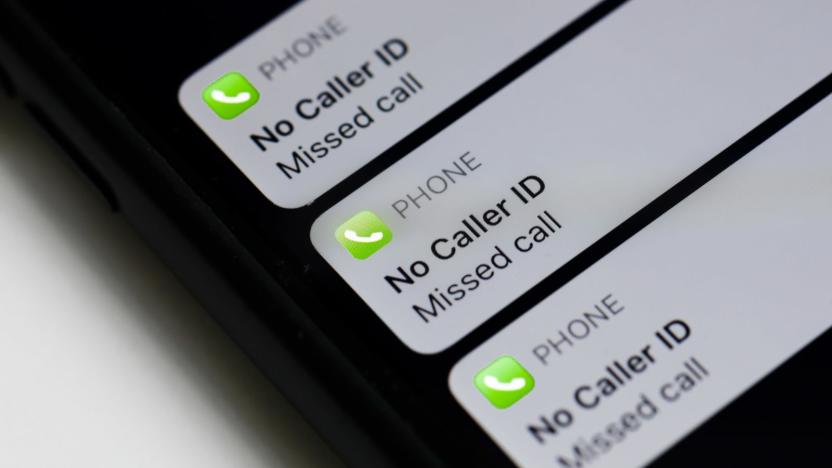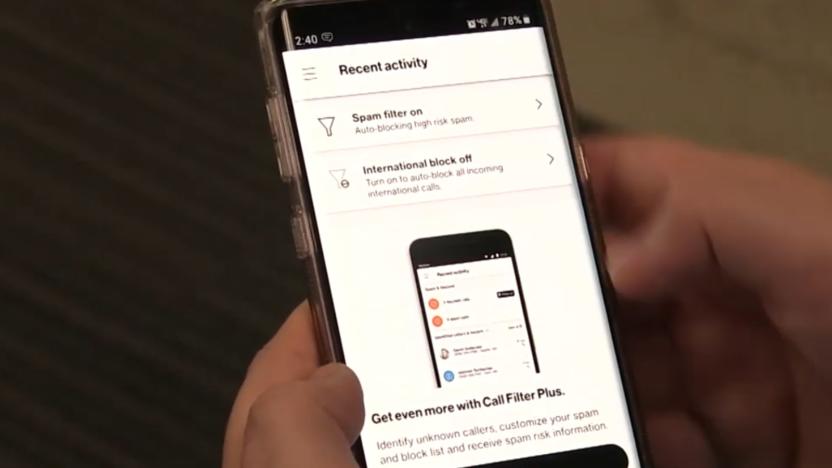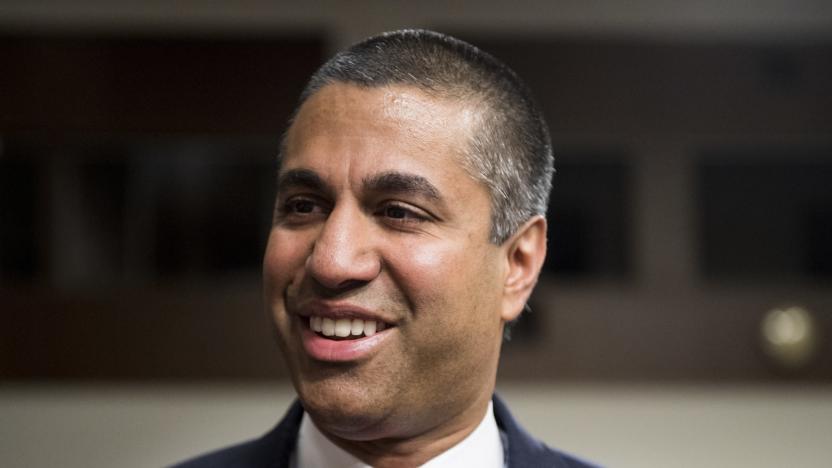caller ID
Latest

T-Mobile's 'Scam Shield' offers free caller ID and spam call blocking features
T-Mobile completed its purchase of Sprint earlier this year, and with those regulatory hurdles out of the way the company is once again announcing some new features for its expanded customer base. The focus is on spam and robocalls, something that T-Mobile says is the number one complaint right now to the FCC. Starting today, T-Mobile is offering its customers a variety of free services to make identifying and avoiding spam calls easier, a program called Scam Shield.

FCC could require phone companies to authenticate calls
Today, FCC Chairman Ajit Pai proposed new rules that would require phone companies to adopt the STIR/SHAKEN protocol, an increasingly popular method for caller ID authentication. The rules are meant to combat robocalls, specifically those that spoof phone numbers, and the FCC is expected to vote on them later this month.

Verizon will automatically opt Android customers into its anti-robocall app
Verizon (Engadget's parent company) rolled out a free version of its spam filter earlier this year in a bid to counteract the tiresome robocalls that so often plague our lives. Now, if you're on Android, you'll get it as standard, so you don't need to do anything to avoid the nuisance.

FCC Chairman wants to ban caller ID spoofing for text messages
FCC Chairman Ajit Pai is advancing the war against robocalls. Today, he proposed adopting rules that would ban caller ID spoofing of text messages and robocalls originating outside of the US. More than 40 state attorney generals have urged the FCC to adopt the new rules, and the Commission is scheduled to vote on them at its August 1st meeting.

Current Caller ID app adds social info, weather details, suggests a good time to ring back
If staring at the incoming callers' visage just wasn't enough, Current's Caller ID might worth a try. The utility app adds a raft of extra detail to your smartphone when it rings, from recent tweets and status updates through to weather conditions and even location data. After loading up the app, you can connect to your Facebook, Twitter and LinkedIn profiles, which Current Caller ID combines with your existing contact list. Based on your use history, the app will even offer up a time to return missed calls. There's the nice addition of some metrics between you and your phonebook, visualizing that precarious balance between text messages and calls with your significant other -- or a timegraph of when you call Mom. These stats are possibly more useful than the caller ID features, and while the design does jar a little with the typical Android aesthetic, it's hard to complain when the app's free. If you're willing to forgive those minor visual flaws, the download awaits at the source below.

Burner turns your iPhone into a disposable, lets you be faux-shady
Need a throw-away phone number? It's now available as the Burner iPhone app, from a company called Ad Hoc. There's no explanation for how it works technically, but using it looks easy: you pay $2 for the app, which gives you a new phone number that lasts for 20 minutes, 60 texts or seven days. The new digits become your caller ID, and afterwards, you can hit the "burn" key to permanently wipe it from the company's servers, then score additional credits plus a new number, if needed. The company sees it being used for things like Craigslist transactions and dating, but if you have less above-board purposes in mind, be aware -- the privacy policy says it "may disclose your personal data if required by law." Check the source below or the Apple store to get it.

Google Voice brings greater control over anonymous and unknown callers
Think about it for a moment: do you recall a single instance when you were actually glad that you answered a telephone call from a blocked number? Unless that bill collector turned out to be your future spouse, the answer is likely no. Now, Google Voice users will find an extra perk in the online settings that should take the edge off of receiving calls from unknown sources. You'll now find the ability to screen anonymous callers, whereby the system will prompt the individual to state their name, and only then will your phone ring. From there, you'll have the option of answering the call, sending it to voicemail, or even listening in as the caller leaves a voice message -- kinda like back in the days of answering machines. Similarly, you'll also find the ability to apply this same screening process to callers who aren't in your address book. As proof that Google isn't a total grouch, it's also thrown in a new option that allows you to customize a warm greeting for those contacts who are, in fact, in your address book. After all, it never hurts to show some love.

T-Mobile Name ID finally brings true caller ID to your cellphone
If you're still rockin' a landline you probably take caller ID for granted at this point and, if you're a mobile only kinda person, you might not even realize your cellphone lacks it. But, the truth is, until now true caller ID has never been available from America's wireless carriers. There were a number of technical hurdles that stood in the way, but today those are officially crumbling as T-Mobile is launching Name ID in conjunction with Cequint, the company behind City ID. Instead of just checking an incoming call against your list of local contacts, the number is also fed through a larger database of publicly listed ones. Any match is displayed when you receive the call and, if the person isn't already in your phonebook, you can easily add them with a tap. Of course, this sort of convenience doesn't come free -- T-Mo will be charging $3.99 a month for Name ID service. At first only Exhibit 4G owners will be able to sign up, but other handsets (including the myTouch 4G Slide) will be added to the list of compatible devices later. Check out the PR after the break. Update: So looks like T-Mo was not first out the box with wireless caller ID here in the US: MetroPCS has offered it for some time and Sprint partnered with Privus Mobile back in March to offer similar features.

T-Mobile leak divulges return of unlimited WiFi calls, may add Name ID and Voicemail-to-Text
What's shaping up to be an epic week in tech news may be about to become even more exciting for T-Mobile fans. Internal employee docs are giving out some serious vibes that the company is ready to push out three important features to many of its phones as early as tomorrow. The first one to put a smile on your face is unlimited WiFi calling, which should be available as a free add-on to the Even More, Even More Plus, and 4G Do More plans. We're glad to see the service come back as a freebie, much better than the $9.99 per month asking price when it was hotspot@home. As if that isn't good enough by itself, the other services getting prepped for tomorrow's lineup include Name ID -- a caller ID service that shows the name, number, city, and state of anyone not listed in your contacts -- and Voicemail-to-Text, a new enhancement to the existing Visual Voicemail service that transcribes the full message into text form on select devices. Keep in mind that while these docs certainly do look official, it's all mere speculation until we hear actual word from T-Mobile about these new programs. With that said, we've got screenshots above and below, so feel free to glean as many details as possible from them.

Comcast's iPhone app gains caller ID capability for triple play customers
Comcast's mobile app for iPhone and iPod touch customers got boosted to version 2.5 in the past few days, bringing with it a handful of tweaks that seems to justify the 0.5 increment. Most notably, the app can now push you a notification when you get a call on your Comcast-provided phone line, but you've also got support for landscape viewing of TV listings (a useful feature, we'd reckon) along with Comcast's Universal ID for unifying logins regardless of which of the company's services you subscribe to. The update is available now; follow the break for the official demo of caller ID notifications in action.

Truth in Caller ID Act of 2010 makes Caller ID spoofing a crime
Caller ID spoofers, your days are numbered! The "Truth in Caller ID Act of 2010" has just passed the House. The bill -- which has been kickin' around in one form or another since 2007, and which only passed the Senate as recently as this February -- makes it illegal "to cause any caller ID service to transmit misleading or inaccurate caller ID information." As Ars Technica points out, there are some exceptions, including blocking your own outgoing caller ID info, and law enforcement is exempt. This bad boy is aimed at any and all real-time voice service, "regardless of the technology or network utilized," ensuring that VoIP is included. Look for the punitive measures (including flogging) to kick in about six months from now. [Warning: PDF read link]

VoiceCentral integrates Google Voice with the iPhone
If you're one of the lucky ones to have scored an invite to Google Voice, check out VoiceCentral. It's a very slick application which integrates well with the iPhone, making it possible to make calls through your Google Voice (or GrandCentral) account. Why would you want this? My primary reason for wanting an application for GV is so that I can make calls and have my Google Voice number appear on the Caller-ID. VoiceCentral makes this a simple process. When you first install the app, it asks you to select your iPhone number on the Settings page. When you make a call through the app, it happens in two steps: 1) your iPhone rings (this is Google Voice's servers calling your iPhone), 2) your call is connected. Why is this important? If you end up leaving a message for whoever you are calling, their voicemail system may give them the option to call you back at the number you called from. Our landline phones also make it easy to return calls from the caller-ID list. As a Google Voice user, I want those calls to go to my Google Voice number, not my iPhone. If you're a fan of Google Voice, you know that having a central place for all of your voicemails is great. Google Voice will transcribe those voicemails (my favorite feature, although sometimes having a computer try to decipher my friend's "late weekend night" messages does lead to some interesting "translation issues"). VoiceCentral will let you access not only those voicemails (in a style very similar to iPhone's own Visual Voicemail) but if you tap on the arrow, it will also show you the transcription. You can even read the message without listening to it, which is especially handy for checking messages when you are in a meeting, a movie theater (oh, like you've never!), or anywhere loud enough that you might not be able to hear it. The transcripts can also be copied (on iPhones running OS 3.0 or later, of course) and pasted into notes or emails if needed. As you'd expect, VoiceCentral also integrates with your existing iPhone contact list, and there's also a keypad which allows you to make calls or send SMS. The "Send SMS" feature has had some issues, but Riverturn has a newer version which fixes the problem. As you are no doubt used to hearing by now, they are waiting on Apple to approve the newer version. It's also important to note that there is no way to designate any application except the built-in Phone app as the default, so any phone numbers which you tap from email messages or web pages will open in the built-in app, rather than in Skype or other telephony apps. Google appears to be readying its own GV iPhone app for release, although it hasn't made it into the App Store yet. Anyone familiar with the approval process knows that could mean it is hours, days, or weeks away from being released. The Blackberry and Android apps are already available. Is $2.99 [iTunes Link] too much to spend on an app when there may be a free alternative right around the corner? Not for me. In fact, the only thing which keeps this app from replacing the native Phone app on my dock is the lack of a "Favorites" tab, which I use for nearly all of the outgoing calls I make on my iPhone.

MetroPCS Screen-it service puts a name to shock callers
Go figure -- MetroPCS, a carrier far from the forefront of most people's mind, is bringing about a feature that couldn't possibly arrive soon enough. The Screen-it service "displays the calling party's name on a subscriber's wireless phone," regardless of whether he / she has said person in their contact list. We know, you landline users have been enjoying this for eons, but up until now, we cellular customers have had to Google phone numbers before the fourth ring in order to find out if it's our dentist or our credit card company calling. Hey, big boys -- can we this stuff out to everyone else not associated with MetroPCS? Thanks.[Via phonescoop]

How to reveal blocked caller ID info: a video guide to risky behavior
Let's say for some reason someone has his or her caller ID blocked and is calling you all the time. Let's then say you really want to know who that person is for, you know, whatever reason -- not that we'd know anything about that. Some crafty phreaker types have come up with a way to do this using an enterprise-spec asterisk box and a SIP trunk provider. In a demonstration video, a hacker tweaks said asterisk box with some new configurations to strip out privacy flags, forward the call to another number, and ultimately reveal caller ID information which, surprisingly, is still available. This isn't meant to be easy, but if the terms "prepend," "SIP trunk," and "asterisk box" don't scare you away, go ahead and watch the video after the break. Big disclaimer: we're not responsible for your broken gear, jail time, or restraining orders.

TWC adds Caller ID on TV in Eastern North Carolina
While Microsoft and the gang are out wondering if folks really want Caller ID on their TV screens, Time Warner Cable is out delivering. Effective immediately, select customers in Eastern North Carolina (from Wilmington to Raleigh) can now see who's calling 'em right on their television screen, but of course, one must be subscribed to digital cable and digital phone to receive the free service. More specifically, Caller ID on TV logs the last ten incoming calls (including the caller's name, number, date, call time and whether he / she enjoys long walks on the beach) and can be turned off if you so choose. The offering is being made as part of a $50 million upgrade in the region, and by this summer, every TWC subscriber in the East Carolina footprint will have access. Personally, we're interested to see what else is bound to come from such a substantial cash investment (more HD, please?). [Disclosure: Engadget is part of the Time Warner family]

Everyone else sued over picture caller ID
A four-pack of carriers is getting sued over the infringement of three 2007 patents that appear to center around the concept of picture caller ID -- but here's the best part, it's actually a different dude from a different company than the one that sued Apple. US Cellular, T-Mobile, Virgin Mobile, and Helio are all named in the suit, suggesting that either the remainder of major US carriers have already licensed the technology, or this so-called Intellect Wireless just has a very bizarre way of choosing its defendants. So here's our question: what picture caller ID technology was patented by some random company in 2007 that these guys could possibly be violating?

Mavizen myBlu solves the iPhone blues, adds caller ID / voice dialing to iPods
You all know by now that June is a long ways away, and even when that glorious month finally dawns, there's a good chunk of us who won't even be able to partake in the iPhone fun due to location. Thankfully, Mavizen has a svelte alternative to pair up the functions of your phone with your current dock-connecting iPod courtesy of the myBlu. This wired / Bluetooth device provides a wired set of headphones and a microphone that you connect to your 'Pod, while the integrated Bluetooth module syncs with your handset. Upon receiving an incoming call, the tunes are halted and the incoming number even shows up on your iPod's screen, quite similar to how the original ROKR functioned, except we're adding an external DAP. Aside from caller ID, it also supports voice redial, most recent call list, and adds an FM tuner to boot, and since it pulls power straight from your docking port, no extra batteries are necessary. Of course, for as sensational as this little gizmo sounds, getting it over here on American soil could prove to a chore in and of itself, but if you're down with locating a Hong Kong importer, you can snag one for around HK$598 ($77).[Via Slashphone, thanks Kory]

Asus showcases SideShow-enabled AiGuru S2 VoIP Skype handset
It sure didn't take long for this SideShow bandwagon to get overcrowded, as now we've even got a VoIP phone touting its SideShow functionality, not to mention its ability to interface with iTunes and Windows Media Player as well. While Asus' first attempt, the AiGuru S1, received lukewarm reviews at best, the refreshed version sports a lot more functionality, a color display, and a much slimmer profile. Aside from playing nice with 802.11b/g networks, touting three hours of talk time, and offering full support for Skype (including Skype ID and caller photos / avatars), this handset also rocks an internal speaker / headphone jack for wireless music playback, and also supports streaming from iTunes / WMP; moreover, users can purportedly check their email right on the display thanks to its SideShow pizazz. Although pricing information was absent, the AiGuru S2 will be hitting shelves alongside those PSTN-to-VoIP motherboards in the first quarter of this year.[Via Skype]

Tangled up in Bluetooth
Listen up LL Cool Stevie J.: would it be really so hard to get your engineering posse on building Bluetooth into the iPod? Seriously, we'd settle for even a Bluetooth dongle at this point, just so we wouldn't have to get scrambled up in our headphones anymore. Because if you guys don't come out with something soon, then we're going to have to settle for these really mediocre things like this BluPod here -- all it does is display caller ID info on your iPod and turn down your music accordingly (oh, and it adds an FM transmitter, too). Ok, nevermind this BluPod (no word on its price, either) -- just get going on that iPhone, m'kay?

USRobotics releases two Skype-certified handsets
USRobotics has just released two new Nokia-esque Skype-certified handsets for the Internet telephony lover on a budget, with the USR9601 USB Internet Phone retailing for just $50, and the USR9602 USB Internet Mini Phone (pictured) going for a mere $25. Both models feature a numeric keypad (duh) for speed dialing your Skype contacts or utilizing the SkypeOut feature if that's your thing, with the 9601 also sporting a back-lit LCD for call status and the all-important Skype caller ID. Also part of the package is some whiz-bang technology that promises to cancel out the echoing and tunnel effect that apparently plague lower-quality handsets; we're not quite sure what they're referring to, though, as every VoIP call we've ever made has been crystal clear and of the highest possible sound quality.









